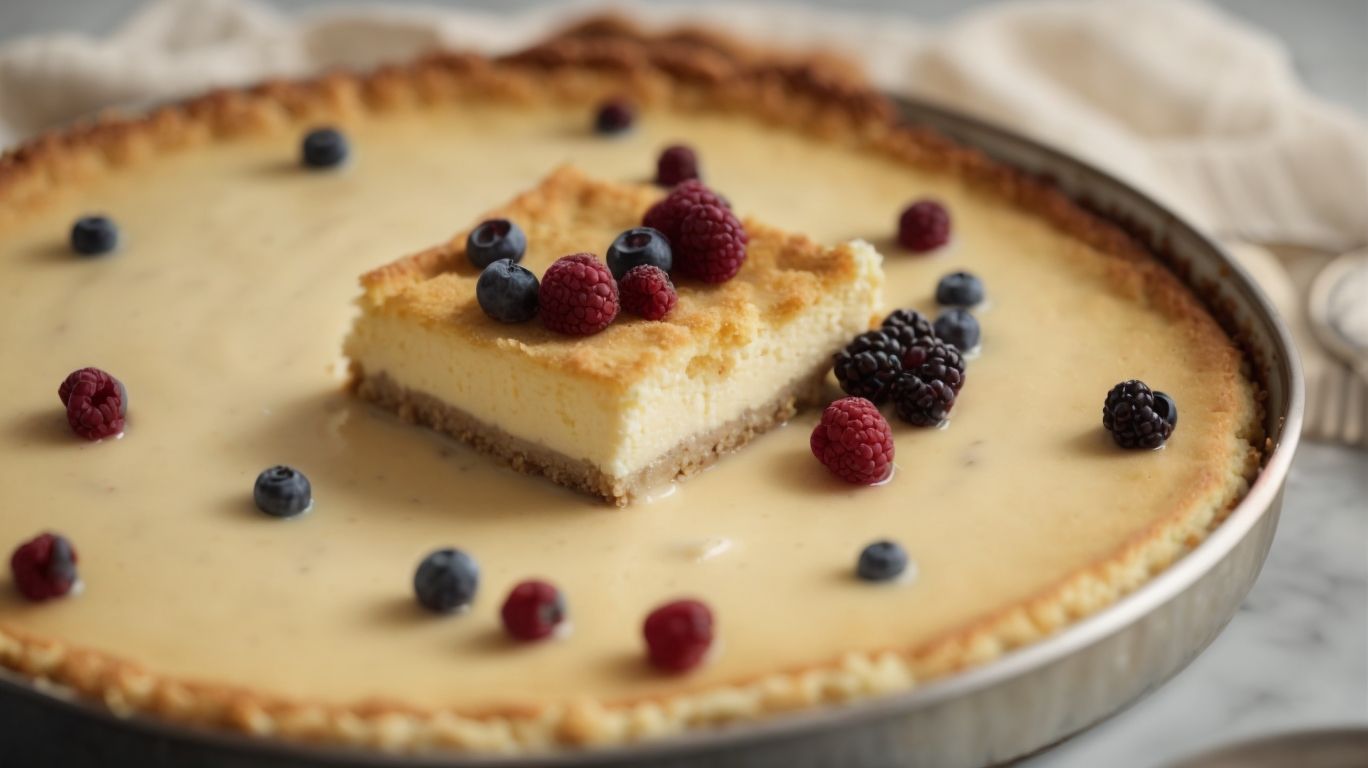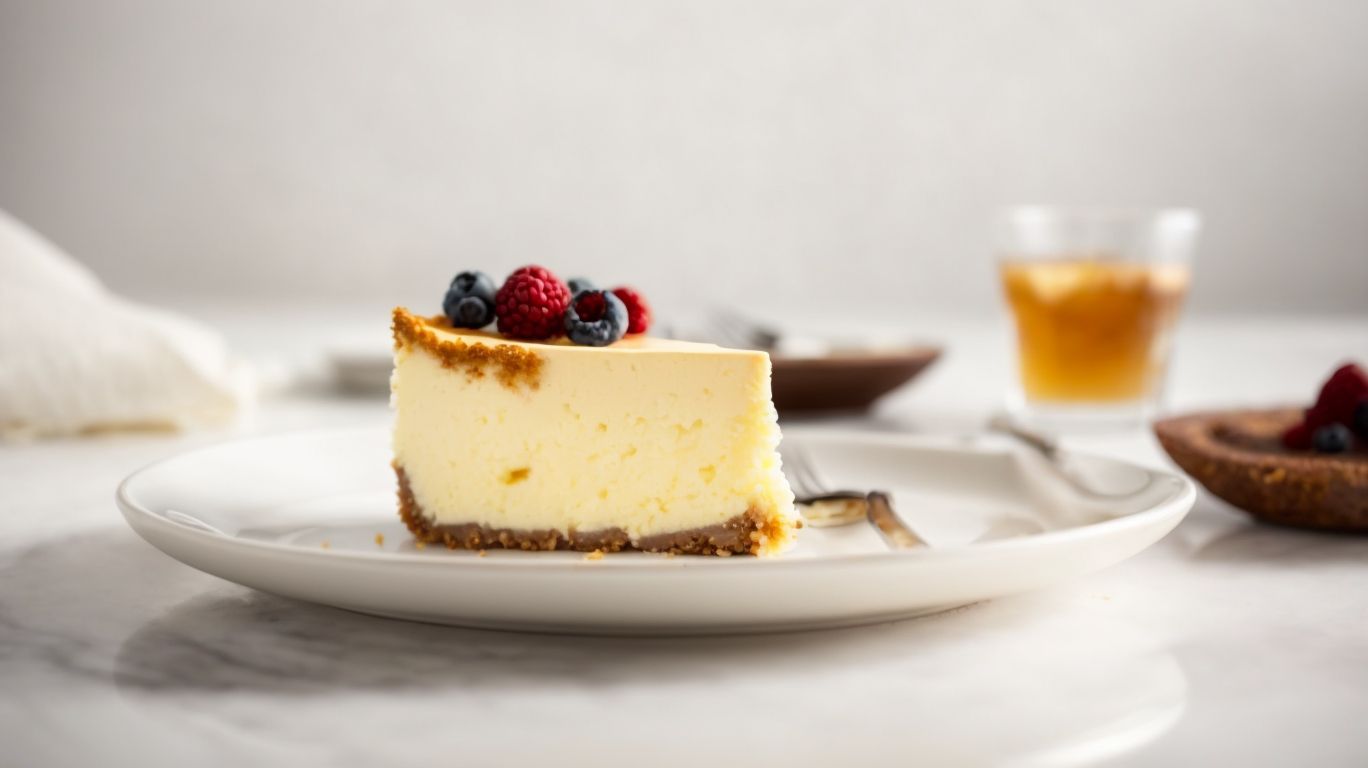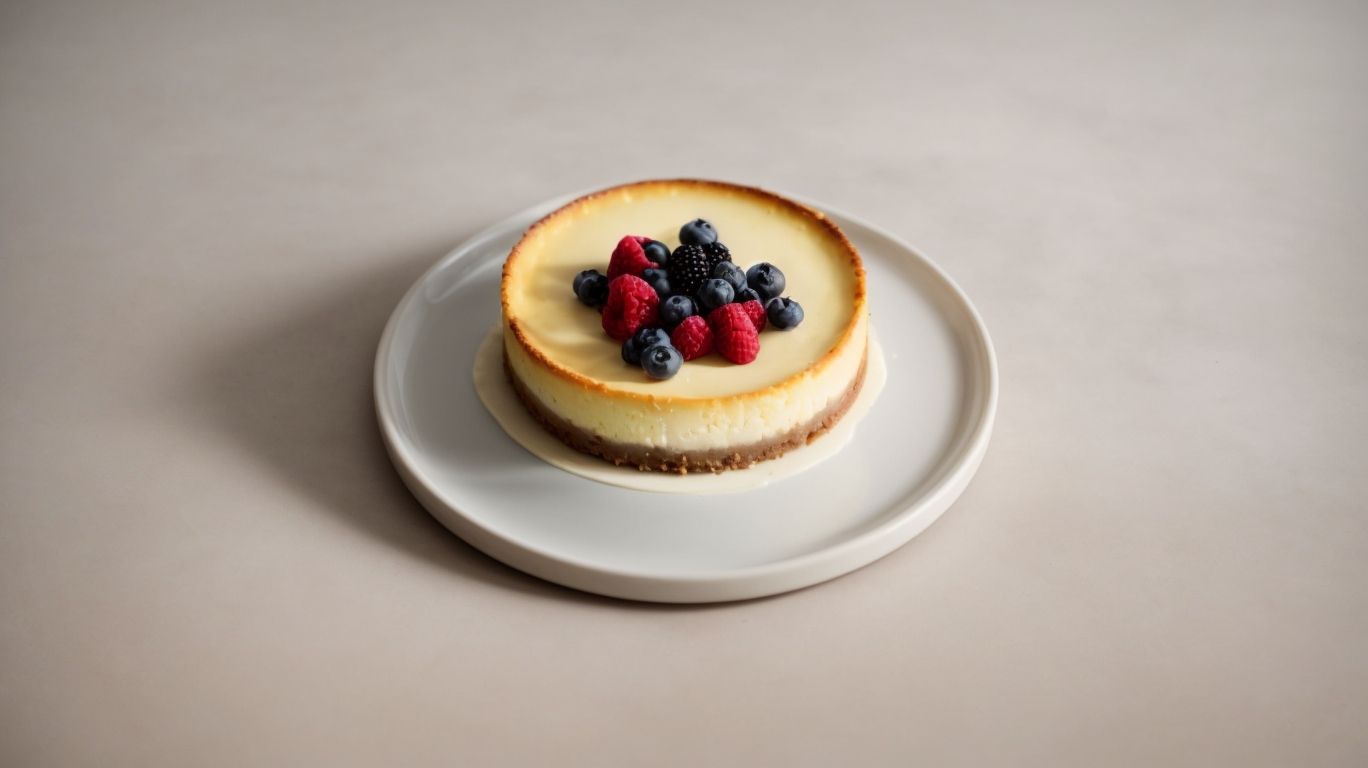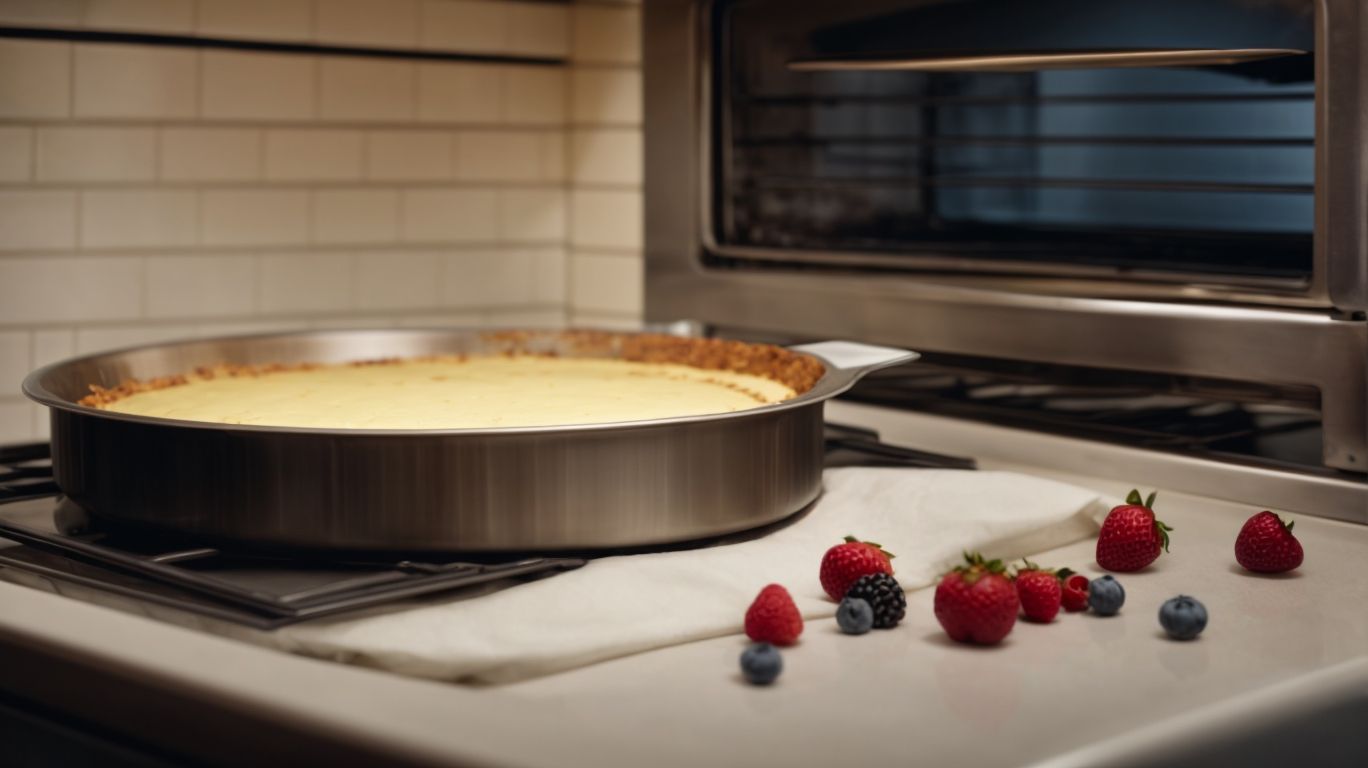How to Bake a Cheesecake Without a Water Bath?
Are you a cheesecake lover who wants to bake a perfect cheesecake without using a water bath?
We will explore the reasons why a water bath is typically used in baking cheesecake, as well as the risks involved in skipping this step.
From cracking to uneven cooking, we will discuss the potential pitfalls and how to avoid them.
Stay tuned for tips on preparing and baking a cheesecake without a water bath for delicious results every time!
Key Takeaways:
What is a Water Bath and Why is it Used in Baking Cheesecake?

Credits: Poormet.Com – Tyler Mitchell
A water bath, also known as a bain-marie, is a baking technique used for cooking delicate foods like cheesecake in a gentle and uniform manner by surrounding the baking dish with hot water.
This method helps in preventing cracking on the surface of the cheesecake by offering a moist baking environment, which reduces the chances of overcooking or drying out the dessert. The water bath acts as a buffer against sudden temperature changes, ensuring the cheesecake cooks slowly and evenly. By maintaining a consistent temperature around the baking dish, the water bath aids in creating a lusciously creamy texture in the cheesecake, resulting in a decadent and velvety dessert that melts in the mouth.
Why Would Someone Want to Bake a Cheesecake Without a Water Bath?
There are several reasons why someone might opt to bake a cheesecake without using a water bath, including time constraints, resource limitations, and personal preferences.
Regarding convenience, skipping the water bath step can significantly reduce preparation time. Not having to carefully wrap the pan in foil, set up a large pan of hot water, and then worry about potential leaks or spills can make the baking process much simpler and quicker.
Some home bakers may not have a suitable pan or the right kitchen equipment to create a water bath setup. In such cases, alternative methods like baking the cheesecake at a lower temperature or using a steam baking technique can still result in a creamy and delicious final product.
Taste preferences play a significant role in the decision-making process. Some people prefer a denser, firmer cheesecake texture that can be achieved without the gentle heat regulation of a water bath. This can result in a slightly different, but equally satisfying, dessert experience for those who enjoy a more decadent cheesecake.
Lack of Time
One common reason for skipping the water bath when baking a cheesecake is the lack of time to set up and monitor the additional baking process.
In the hustle and bustle of daily life, finding the hours needed for the meticulous preparation of a water bath can be a challenge. Opting for a ‘no-water bath’ method to bake a cheesecake is a practical choice for those seeking efficiency in the kitchen. If time is of the essence, quick alternatives such as placing a pan of hot water on the rack beneath the cheesecake might offer a middle ground. Adjustments in baking techniques, like slightly reducing the oven temperature or baking for a shorter duration, can help counterbalance the absence of the water bath.
Lack of Resources
Limited kitchen resources or baking equipment may also lead individuals to bake a cheesecake without a water bath, opting for simpler methods of preparation.
One common alternative method involves increasing the moisture content in the oven by placing a pan of water on the rack below the cheesecake. This can help create a steamy environment that prevents the cheesecake from drying out or cracking during baking.
Another useful tip is to bake the cheesecake at a lower temperature for a longer period. By doing so, you can achieve a gentle and gradual cooking process that promotes a creamy texture without the need for a water bath.
Personal Preference
Some individuals may choose to bake their cheesecakes without a water bath due to personal preferences regarding texture, crust consistency, or flavor profiles.
Regarding cheesecake baking, the decision to skip the water bath can lead to various outcomes. For those who prefer a denser texture, opting out of the water bath can result in a firmer consistency that holds its shape well. On the other hand, individuals seeking a creamier and silkier cheesecake may find that using a water bath helps in achieving that desired velvety smoothness.
Personal taste plays a crucial role in determining whether a water bath is necessary during the baking process. Some people enjoy a slightly drier cheesecake with a more pronounced crust, while others prefer a softer, more luscious filling with a less defined edge.
What are the Risks of Baking Cheesecake Without a Water Bath?
While baking a cheesecake without a water bath is possible, it poses certain risks such as increased likelihood of cracking, uneven cooking, and potential sinking of the cake.
Cracking is one of the most common issues when baking a cheesecake without a water bath. The lack of moisture in the oven can lead to the cheesecake drying out too quickly, resulting in unsightly cracks on the surface. These cracks not only affect the appearance of the cheesecake but also impact its texture.
In addition, without the gentle, indirect heat provided by a water bath, the cheesecake may cook unevenly. This can result in overcooked edges and an undercooked center, leading to a disappointing final product.
Structural flaws, such as sinking in the middle of the cheesecake, are also more likely to occur without the protective barrier of a water bath. The gradual and consistent heat from a water bath helps the cheesecake set evenly, reducing the chances of a collapsed or sunken center.
Cracking
One of the primary risks of baking a cheesecake without a water bath is the increased likelihood of cracking on the surface due to uneven heat distribution.
Cracking in cheesecakes occurs when the outer edges of the cheesecake bake faster than the center, leading to stress on the surface. This stress manifests as visible cracks once the cheesecake cools. To prevent this issue, a water bath is often used during baking to regulate the temperature and provide gentle, even heat. Placing the cheesecake in a water bath insulates it from direct heat, ensuring that the entire cheesecake bakes uniformly.
Another effective method to prevent cracking involves baking the cheesecake at a lower temperature for a longer duration. This slower baking process allows the cheesecake to set gradually, minimizing the risk of cracks forming on the surface.
If cracks do appear on your cheesecake despite precautions, don’t worry! You can always cover them up with a flavorful topping, such as a fruit compote or a dusting of powdered sugar. The taste will still be delicious, and these solutions will maintain the aesthetic appeal of your dessert.
Uneven Cooking
Baking a cheesecake without a water bath can result in uneven cooking, leading to variations in texture, doneness, and overall quality of the dessert.
Uneven cooking when baking cheesecakes without a water bath is a common issue faced by many home bakers. Without the gentle heat transfer from the water bath, the edges of the cheesecake tend to cook faster than the center, resulting in a cracked or sunken top. This can leave the dessert undercooked in the middle yet overcooked around the edges.
To troubleshoot this problem, consider lowering the oven temperature slightly to slow down the cooking process. Tenting the cheesecake with foil during the latter part of baking can help prevent excessive browning on the edges.
Sinking
Sinking is another risk associated with baking a cheesecake without a water bath, as the cake may collapse or lose its volume during or after the baking process.
When a cheesecake sinks, it can create an unappealing appearance and affect the overall texture. This issue typically arises due to the drastic temperature change when the cake transitions from the oven to room temperature.
To prevent sinking, ensure that the cheesecake is gradually cooled after baking. Avoid placing the hot cake in a drafty area or in direct contact with a cold surface.
Corrective measures include refrigerating the cheesecake for several hours to firm it up and solidify its structure.
How to Prepare for Baking Cheesecake Without a Water Bath?

Credits: Poormet.Com – Dennis Taylor
Proper preparation is essential when planning to bake a cheesecake without using a water bath, requiring attention to pan selection, preparation techniques, and batter consistency.
When choosing a pan for your cheesecake, opt for a heavy-duty springform pan to help distribute heat evenly. To prevent the batter from leaking, tightly wrap the outside of the pan with heavy-duty aluminum foil.
Ensure your ingredients are at room temperature and mix the batter gently to avoid incorporating too much air, which could lead to cracking. Adjust the baking time and temperature slightly to compensate for the lack of a water bath; a lower temperature and longer baking time may be necessary.
Choosing the Right Pan
Selecting the appropriate pan for baking a cheesecake without a water bath is crucial to ensure even heat distribution and prevent potential issues like overcooking or uneven baking.
When choosing a pan for your cheesecake, consider the material first. A metal pan is often preferred as it conducts heat efficiently, promoting even baking. Avoid using glass or ceramic pans, as they may lead to uneven cooking due to slower heat transmission.
The size and shape of the pan impact the baking outcome. Opt for a pan that matches the recipe’s specified size to ensure proper thickness and cooking time. A springform pan with a removable bottom is commonly recommended for easy release and presentation of the delicate cheesecake.
Preparing the Pan
Properly preparing the pan for baking a cheesecake without a water bath involves greasing, lining, or insulating the pan to promote easy release and even cooking of the dessert.
To properly grease the pan, use a neutral-flavored oil or butter and ensure you cover all the inner surfaces, including the bottom and sides, by using a brush or paper towel. Parchment paper can be used to line the bottom of the pan, preventing the cheesecake from sticking. Cut it to size and press it into the greased pan smoothly. Insulating the pan can help prevent cracking. This can be achieved by wrapping the outside of the springform pan in heavy-duty foil or placing it in a larger pan filled with hot water during baking for more consistent heat distribution.
Preparing the Cheesecake Batter
The preparation of the cheesecake batter plays a critical role in ensuring a successful baking outcome without a water bath, involving proper mixing, ingredient incorporation, and consistency adjustments.
When beginning the process, it’s essential to gather all your ingredients at room temperature to prevent lumps and encourage smooth blending. Use a mixing technique that combines the cream cheese and sugar until creamy and free of any clumps, ensuring a light and airy texture in the final product. Incorporate eggs one at a time, mixing just enough to combine without overbeating, which can lead to a dense cheesecake. Strive for a batter that is velvety and homogeneous, ready to be poured into your prepared crust for baking.
What are the Steps for Baking Cheesecake Without a Water Bath?
Baking a cheesecake without a water bath involves specific steps such as preheating the oven, baking the crust, pouring the cheesecake batter, and cooling the dessert gradually to prevent cracks.
After preheating the oven to the recommended temperature, it’s crucial to ensure the crust is perfectly baked before adding the creamy cheesecake filling. Once the crust is ready, delicately pour the cheesecake batter on top, making sure it spreads evenly to achieve a smooth texture. As the cheesecake bakes, keep a close eye on its appearance, ensuring it turns a light golden color without burning.
Post-baking, the proper cooling process is essential. Turn off the oven and let the cheesecake sit inside with the door slightly ajar for a gradual cooling process.
Preheat the Oven
Preheating the oven to the correct temperature is the initial step in baking a cheesecake without a water bath, ensuring proper heat distribution for even cooking.
When the oven is preheated to the right temperature, it sets the stage for the cheesecake to bake perfectly. This crucial step allows the batter to start cooking immediately, leading to a stable and consistent rise during baking. The ideal oven temperature ensures that the cheesecake cooks uniformly, preventing any overbaking or underbaking issues. A well-preheated oven also helps in developing the desired texture and flavor profile of the cheesecake, resulting in a delightful dessert that is evenly cooked from edge to center.
Bake the Crust
Baking the crust before adding the cheesecake filling is a crucial step in the process of baking a cheesecake without a water bath, ensuring a crisp foundation for the dessert.
Start by preparing your cheesecake crust mixture, typically a blend of crushed cookies or graham crackers, sugar, and melted butter. Firmly press this mixture into the bottom of your springform pan, ensuring an even layer and slightly pressing it up the sides for that classic crust edge.
Regarding the baking process, preheat your oven to the recommended temperature, usually around 350°F. Bake the crust separately for about 10-12 minutes to set it before adding the creamy cheesecake filling.
Allow the crust to cool slightly before pouring in the filling to avoid a soggy base. This method eliminates the need for a water bath and simplifies the baking process, providing a delicious cheesecake with a perfect crust every time!
Pour in the Cheesecake Batter
Gently pouring the prepared cheesecake batter onto the pre-baked crust is a key step in the baking process without a water bath, ensuring smooth distribution and minimal disturbance to the crust.
When pouring the cheesecake batter, the consistency plays a crucial role. A thick batter might not spread evenly, leading to an uneven texture. Conversely, a too-thin batter can cause the layers to mix, affecting the final presentation.
To achieve the perfect consistency, gently stir the batter to remove any lumps but avoid overmixing. This will ensure a smooth and creamy texture when baked.
After pouring, take your time to level the filling. Use a spatula or the back of a spoon to carefully spread the batter evenly across the crust. This not only enhances the appearance but also aids in even baking.
Bake and Cool the Cheesecake
The final steps of baking and cooling the cheesecake without a water bath involve monitoring the baking time, testing for doneness, and allowing gradual cooling to prevent cracks and maintain texture.
Once the cheesecake is in the oven, resist the urge to open the door frequently; the drastic temperature changes can lead to cracking. The optimal baking time typically ranges between 45 to 60 minutes, depending on the recipe and oven.
To test for doneness, gently shake the pan; the center should have a slight jiggle while the edges are set. After baking, turn off the oven and let the cheesecake sit inside with the door slightly ajar for about an hour.
How to Prevent Cracking in a Cheesecake Baked Without a Water Bath?

Credits: Poormet.Com – Christian Garcia
Preventing cracking in a cheesecake baked without a water bath requires attention to detail in preparation, baking techniques, and post-baking cooling methods to ensure a smooth and crack-free dessert.
One crucial tip is to have all ingredients at room temperature before starting, as this allows for even mixing and a smoother batter. When combining ingredients, avoid overmixing, which can introduce air into the batter and lead to cracking during baking. Another strategy is to bake the cheesecake at a precise temperature; a lower and slower bake often prevents cracking compared to high heat. After the cheesecake is done baking, allow it to cool gradually by turning off the oven and letting it sit inside with the door slightly ajar. This slow cooling process helps to minimize drastic temperature changes that can cause cracks as the cheesecake settles. By being mindful of these factors, you can significantly reduce the chances of your cheesecake developing unsightly cracks.
Conclusion: Tips and Tricks for Perfect Cheesecake Baking Without a Water Bath
Mastering the art of baking cheesecakes without a water bath involves implementing specific tips and tricks to achieve consistent and delicious results every time.
One essential tip is to let all your ingredients come to room temperature before you begin. This helps ensure a smooth and creamy batter, which is crucial for a perfect cheesecake texture. Be sure to properly prepare your springform pan by greasing it and lining the bottom with parchment paper to prevent sticking. Regarding baking, consider using a water pan placed on the rack beneath the cheesecake to create a moist baking environment without the need for a water bath, keeping the cheesecake from cracking.
Frequently Asked Questions
Can I bake a cheesecake without a water bath?
Yes, it is possible to bake a cheesecake without using a water bath. There are alternative methods you can try to achieve a perfectly baked cheesecake.
What is the purpose of a water bath when baking a cheesecake?
A water bath helps to create a gentle and even heat distribution around the cheesecake, preventing cracks and ensuring a creamy texture.
How do I know if a water bath is necessary for my cheesecake recipe?
Some cheesecake recipes may specify the use of a water bath, while others may not mention it at all. If your recipe does not mention a water bath, you can still choose to use one to achieve the best results.
What can I use as an alternative to a water bath?
You can use a roasting pan filled with boiling water and place your cheesecake pan inside, or you can place a shallow pan filled with water on the bottom rack of your oven.
Can I skip the water bath if I don’t have the necessary equipment?
Yes, you can still bake a cheesecake without a water bath. Just be sure to keep an eye on the baking time and temperature, as it may vary without the use of a water bath.
Will my cheesecake still turn out well without a water bath?
While a water bath is a recommended method for baking a cheesecake, it is not the only way to achieve a delicious and creamy result. With proper techniques and baking adjustments, your cheesecake can still turn out beautifully without a water bath.

